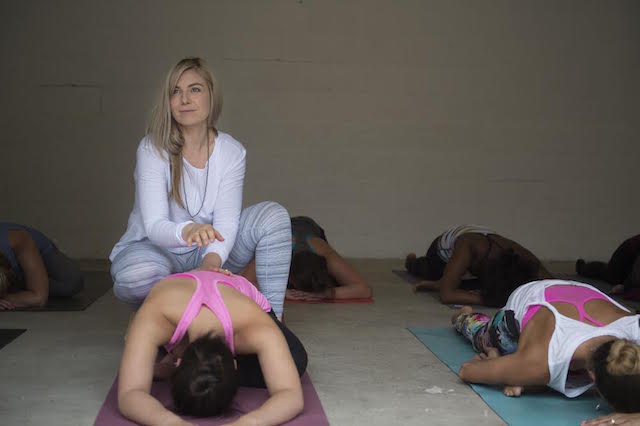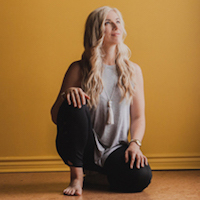As with many yoga teachers, my first year of teaching included a lot of demonstrating—but it never felt right in my heart or body.
Aside from the groin injury I sustained from demonstrating a lunging pose and exiting suddenly to help a student, it was such a paltry experience of practice. There was no integration, no inner practice and no breath awareness. I felt that demonstrating cheapened my experience of asana and ultimately cheapened my students’ experience of class.
Now I teach almost my entire class off the yoga mat; I haven’t brought one with me to class for years, and I’m 100 percent available to my students. Here are a few reasons why I continue to cultivate this approach and how it has set me apart as a teacher.
>> I don’t believe that when I teach it’s my time to practice.
It’s their time to practice. With the increasing competitiveness of the yoga industry and the typically high associated cost, I want to give them the best experience possible. I want them to cultivate an inner awareness, and diminishing the temptation of watching the teacher is the perfect place to start.
>> A component of that experience is hands-on enhancements.
Not corrections or adjustments, but enhancements. I’m specific with the word because I want people to have a stronger, deeper, more nourishing experience without feeling picked on and criticized. We live in a culture that’s competitive, narcissistic and simultaneously insecure. I want to offer yoga that expands my students’ consciousness through calm and challenge, and I can help them reside in these states in a supported way.
>> Any truly necessary corrections can be made through verbal cuing!
I teach a yoga class a lot like a game of Simon Says: put your right hand here, left foot there, engage this, relax that, and now breathe. Sure, sometimes I need to show what I meant if the cues don’t land, but we teach so many postures that don’t have specific names these days that knowing how to cue specifically is a useful skill. Some people can approximate by looking around, but they can’t tell what’s being engaged or relaxed in a pose purely by sight. Those nuances come with verbal cues and individual experimentation.
>> If you injure yourself as a teacher, what do you do when you need to teach?
Having completed several teacher trainings, I tell my students all the time: “You don’t have to teach like me, but I recommend that you get the methodology in place and then choose if you want to demonstrate more.” No one ever starts demonstrating on their mats and then gets comfortable enough to move off.
>> It actually allows me to get quiet and provide more silence for the students.
If we’ve got our roster of cues for a pose and we’re not watching our students, we might be sharing what they’re already doing or missing out on what specific help they need. If they’re doing it all and we can see that, let them abide in their experience with more quiet.
The wonderful thing about teaching? It’s like personal practice: there’s no one way, and all paths can lead to the same outcome. What works for me may not work for you or your teacher, but I believe this method has made me of greater service to more students. It’s made my teaching practice calmer, more conscious and less injury-prone—and more healing for those who seek to learn with me. To me, that’s worth easing off the mat.
~
Author: Kathryn Flynn
Image: courtesy of author
Editor: Toby Israel
~


 Share on bsky
Share on bsky





Read 1 comment and reply